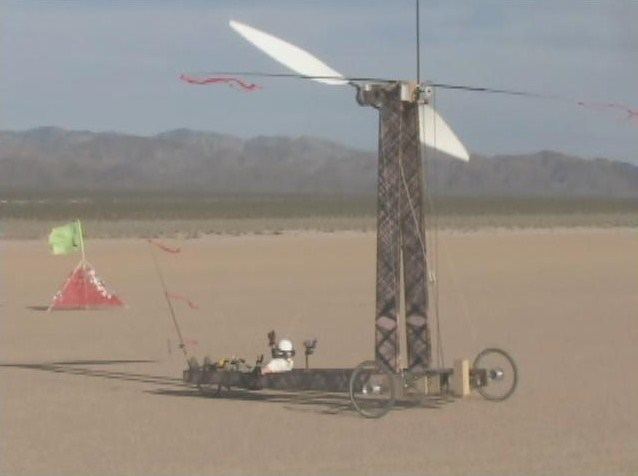 | ||
Blackbird is an experimental land yacht, built by Rick Cavallaro and John Borton of Sportvision, sponsored by Google and Joby Energy in association with the San Jose State University aeronautics department to demonstrate that it is possible to sail directly downwind faster than the wind. In a test supervised and recognized by the North American Land Sailing Association in July 2010, Cavallaro achieved a speed of 27.7 mph (44.6 km/h) in 10 mph (16 km/h) winds: almost three times the speed of the wind.
Contents
History
In 2006, following a viral internet debate started by Rick Cavallaro as a brain teaser, a propeller-driven land yacht was built and filmed, demonstrating that it is possible to sail 'dead' downwind faster than the wind by the power of the available wind only.
In 2009, professor Drela of MIT worked out the equations for such a device and concluded that one could be built "without too much difficulty". Other researchers arrived at similar conclusions.
In the same year, after being challenged that the video was a hoax, team members Rick Cavallaro and John Borton of Sportvision, sponsored by Google and in association with the San Jose State University aeronautics department, built a test vehicle nicknamed Blackbird. A year later, in 2010, Cavallaro successfully tested the vehicle, achieving more than 2 times the speed of wind, definitively demonstrating that it is possible to build a vehicle which can achieve the claim. A second test with an improved vehicle in 2011 reached close to 3 times the speed of wind.
After proposing the vehicle's design, and presenting the analysis to demonstrate its viability, the Blackbird team learned that others had previously conceived and built similar designs - most notably Andrew Bauer of Douglas Aircraft built and demonstrated such a vehicle in 1969, based on an analysis presented in a student's paper from some 20 years earlier.
Bauer observed "a rearward deflection of a foot-long tuft located about 12 feet forward of the propeller plane" thus conclusively demonstrating that his vehicle went faster than the wind (that is, Bauer observed that a streamer located well forward of the propeller was deflected backwards by the apparent wind, meaning that the vehicle was going faster than the real wind). There are no known independent verification to Bauer's claims, although there are several sources of engineering and scientific articles, explaining the theory and physics of such a device. Besides still photography, a film has been found showing it in operation.
Explanation
Conventional sail-driven boats, while not going directly downwind, can tack left and right of the wind's direction to achieve speeds towards their downwind destination (velocity made good) greater than the speed of the wind, but cannot move faster than the wind while sailing in the same direction as the blowing wind ("dead downwind"). Consider two boats connected by a rope, tacking downwind, both synchronising their operation so that they are always on opposite tacks. This system, seen as a single craft, already can achieve downwind travel faster than the wind speed.
By using a propeller instead of a conventional sail, and coupling the propeller to its wheels, a land yacht can proceed dead downwind faster than the wind. A similar effect can be achieved in water: instead of driving a propeller from the wheels of the craft, a boat could be built with a submerged water turbine providing the energy to drive the propeller.
Achievements
On 7 and 8 March 2010, the team reported testing their vehicle on a motor-driven moving belt (treadmill), showing that it would advance against the belt, which means that it can progress dead downwind faster than the wind.
On 24 March 2010, the team ran the vehicle on the Ivanpah dry lake bed south of Las Vegas, Nevada, showing that it could accelerate dead downwind from a standstill and reach velocities well in excess of wind speed. That is, the vehicle was progressing dead downwind faster than the wind. Officials of the North American Land Sailing Association (NALSA) were in attendance and one NALSA Board of Directors member (Bob Dill) was there for every run and collected his own rough wind and GPS data. This was not a NALSA-sanctioned event but was presented as a demonstration to the NALSA Board of Directors that the vehicle was capable of progressing dead downwind faster than the wind. Subsequently, the team worked out the details with NALSA for rules and instrumentation related to an upcoming official NALSA ratified test and record.
On July 2, 2010, Blackbird set the world's first certified record for going directly downwind, faster than the wind, using only power from the available wind during its run. The yacht achieved a dead downwind speed of about 2.8 times the speed of the wind.
On June 16, 2012, Blackbird set the world's first certified record for going directly upwind, without tacking, using only power from the wind. The yacht achieved a dead upwind speed of about 2.1 times the speed of the wind.
